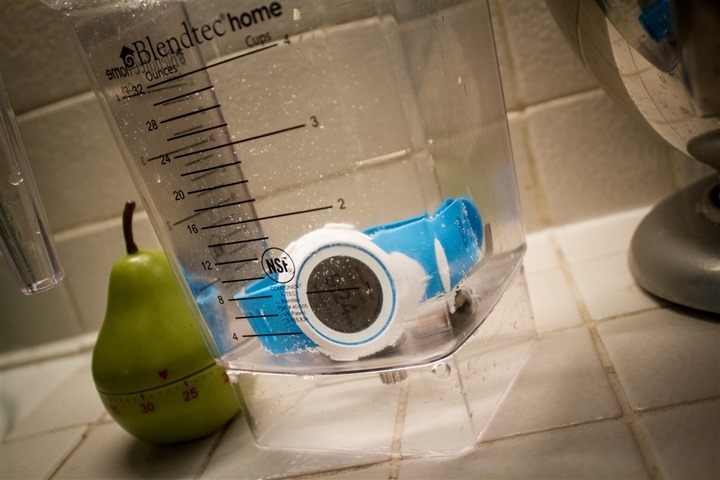Garmin Fenix3 HR In-Depth Review
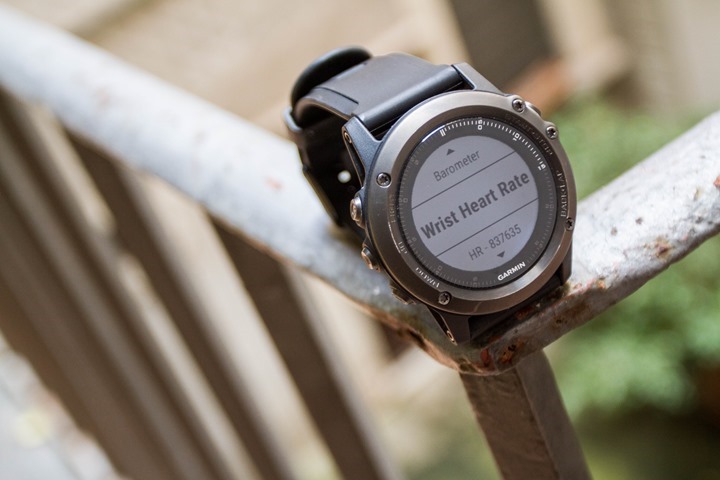
Last month at CES in Las Vegas, Garmin introduced their most advanced wearable device with an optical heart rate (HR) sensor in it – the Fenix3 HR. This device took Garmin’s Elevate optical HR sensor and added it to their hugely successful Fenix3 watch, which has become Garmin’s most advanced watch for multisport athletes (seemingly surpassing the higher end Epix along the way with new features).
I’ve been using a few different versions of the Fenix3 HR since that timeframe. However, this review is shaped on runs/rides/activities since the unit started shipping about three weeks ago. As such, it’s a final production device with the final firmware on it. Like always, once I’m done with this review I’ll wrap it back up and ship it back to the Garmin folks in Olathe, Kansas.
Within this period I’ve used the device virtually 24×7, attempting to understand all its ins and outs. I’ve taken it running, swimming, cycling, skiing, and done general gym workouts as well. Plus of course just using it as a day to day smartwatch. Based on that, I’ve got a pretty good grasp on how well it works (and where it stumbles).
However – I’m doing something a bit different with this review. Specifically, I’m just focusing on a few core features of the Fenix3 HR that are different from the Fenix3 that I’ve already reviewed. That’s because the Fenix3 has a massive feature set. Realistically there are hundreds of features in the unit, all of which would take months to review again in full-depth. And realistically, 99% of those haven’t changed since the first edition. So rather than you have to wait till spring to tell you what you already know, I’m just going to focus on the new stuff. If you’re looking for some of the basics around how the Fenix3 works in general, swing on over to my existing Fenix3 In-Depth Review.
Sound good? Let’s get cooking!
Unboxing:
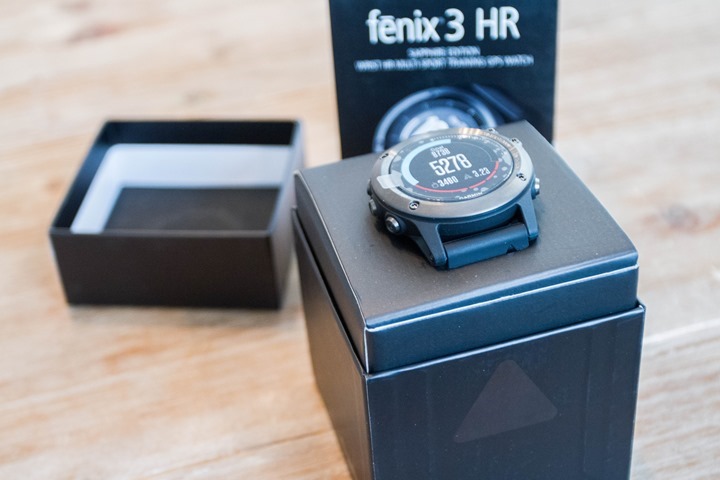
First up, we’ve got to get this thing unboxed. Thankfully, that’s a rather simple process.
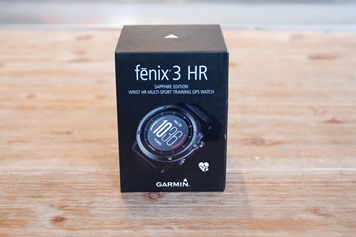
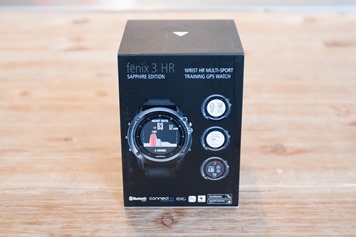
After taking apart the three-piece box, you’ll find basically three things:
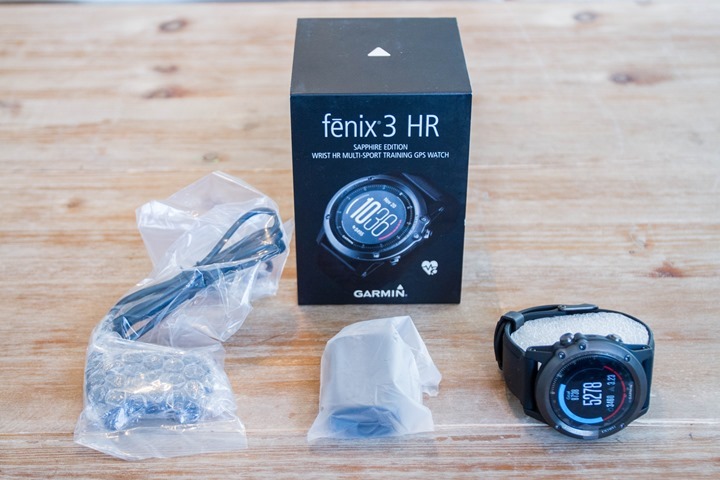
You’ve got the charging cable, the watch, and the power adapter.
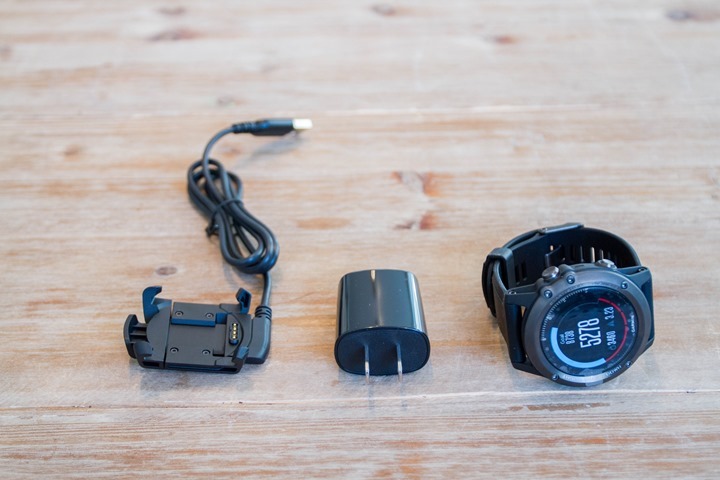
Starting with the charging clip, it’s very similar to the existing charging clip for the original Fenix3:
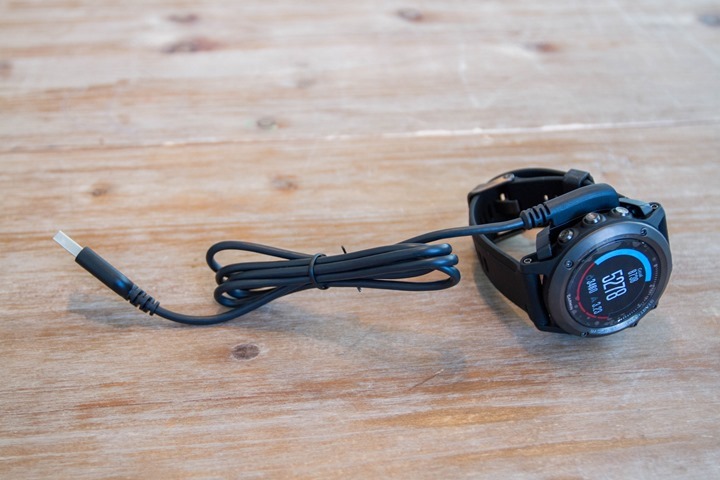
The difference though is that you’ll see a slight chunk taken out of the middle of it, which is where the optical sensor sprouts out of the watch.
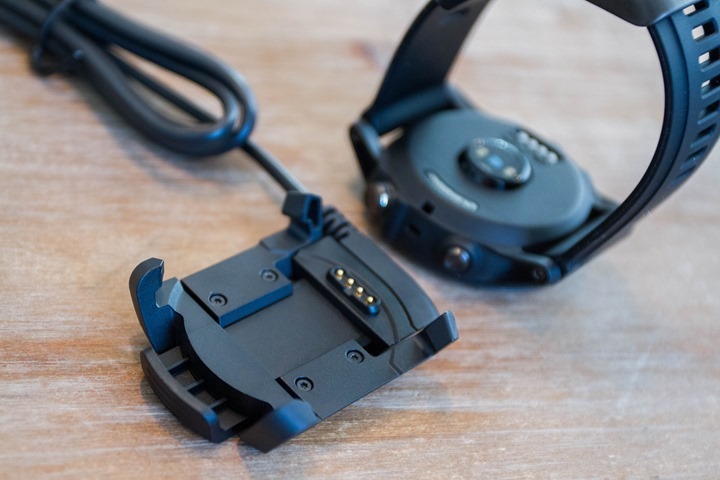
That said, in a pinch, you can actually use the original Fenix3 charging cable, just don’t snap in both sides (kinda leave it alone sitting there). Inversely, you can easily use the Fenix3 HR cable with a regular Fenix3. There’s also the small wall adapter. Or, you can just plug it into any USB port you find and it’ll happily charge.
Last up you’ve got the watch itself. Basically, it looks just like the original Fenix3 from the front, but has the tell-tale optical HR sensor bump on the back.
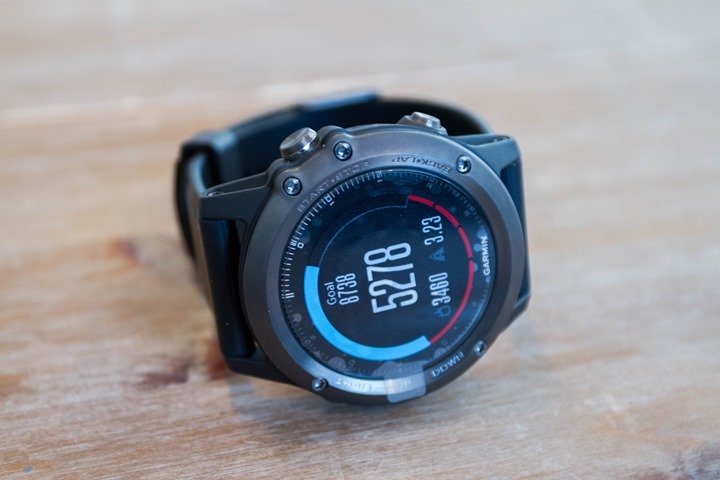
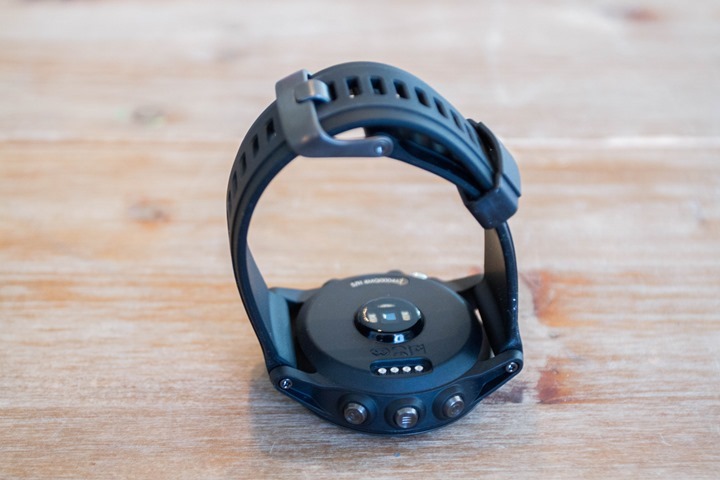
Note that the Fenix3 HR comes in a few different strap variants. This review includes the regular strap, but there’s also a leather strap available. You can use pretty much any Fenix3 strap you’d like though, assuming it doesn’t block the optical sensor (more on that later).
Size & Weight Comparisons:
For the most part, the Fenix3 HR isn’t really that much different from the regular Fenix3. The exterior front-facing shell is identical. So much so that outside of some very subtle style tweaks to the front, you’d be unable to tell the difference apart unless you really knew what to look for.
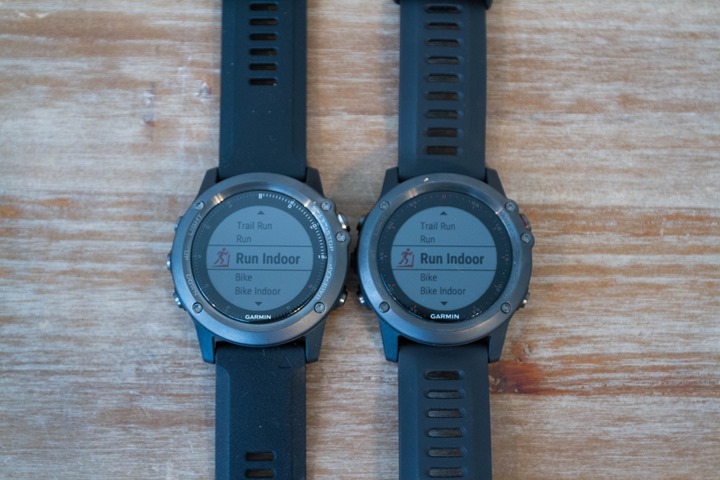
Of course the real changes are on the back of the unit – which houses the optical HR sensor. It’s here that you find the small sensor bump.
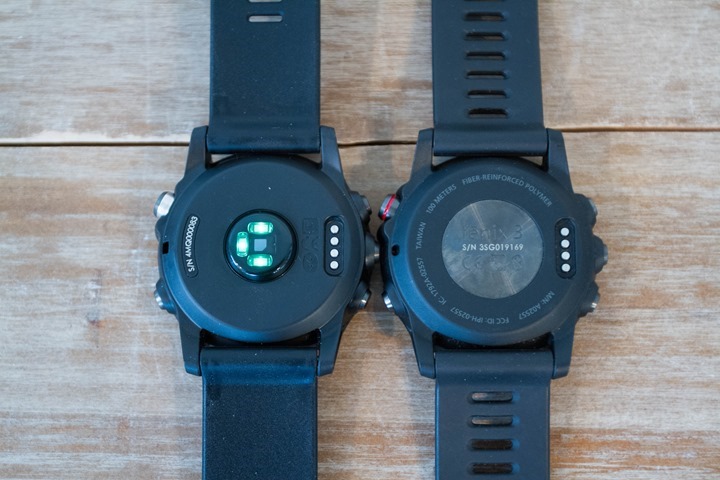
This sensor bump is no different than that found on the FR235, Vivosmart HR, and Vivoactive HR – all of which contain Garmin’s Elevate sensor.
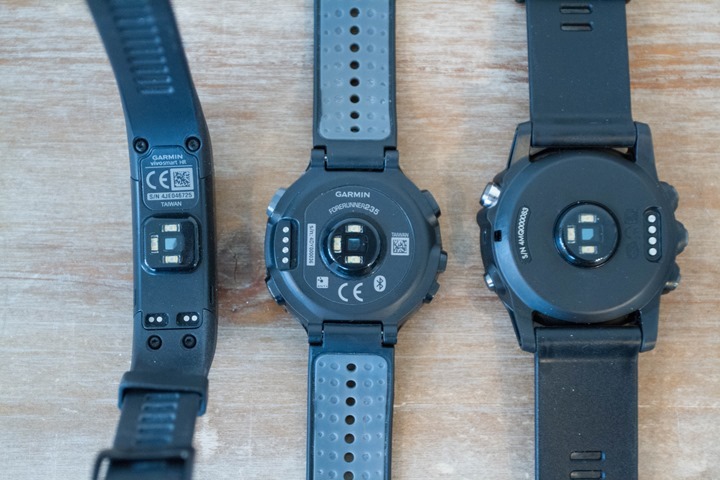
It’s a small bump that I honestly don’t feel at all, since that portion of your skin is fairly soft and so for me it’s just not something that I notice. There are however a handful of people that do notice sensor bumps (from any number of companies).
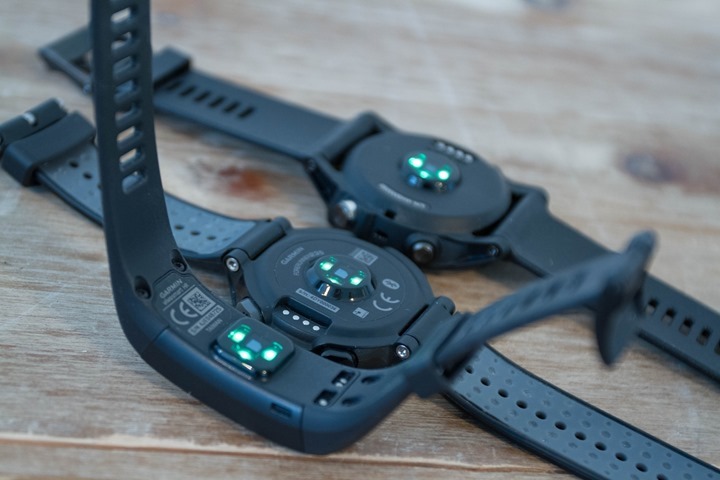
When it comes to weight, it’s not terribly different there either. You can see it below coming in at 90g, versus the original Fenix3 (red variant) being 83g.
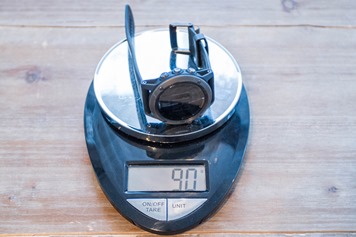
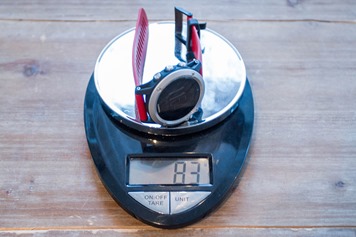
Note that depending on the exact band you place on the unit, you will get different weights or widths/textures. There are no doubt a lot of options today in that category:
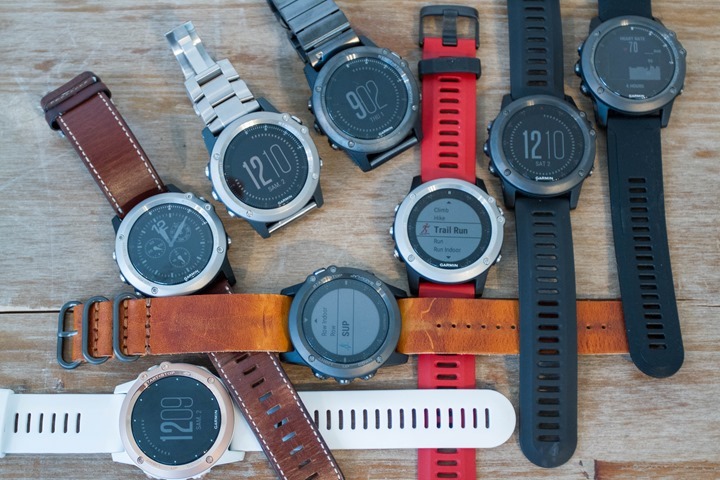
However, keep in mind that you are unable to use any strap/band system that blocks the optical HR sensor (at least if you care about the HR sensor). For example, neither the fabric/nylon NATO-style straps will work (since they’d block the sensor) or the Fenix3 Quick Release Kit. Both of which block the sensor entirely. Again, you can use nylon straps, but you just won’t get optical HR readings and will want to disable the sensor and use a chest strap via ANT+ instead. Whereas the quick release kit simply won’t fit.
24×7 Optical HR Tracking:
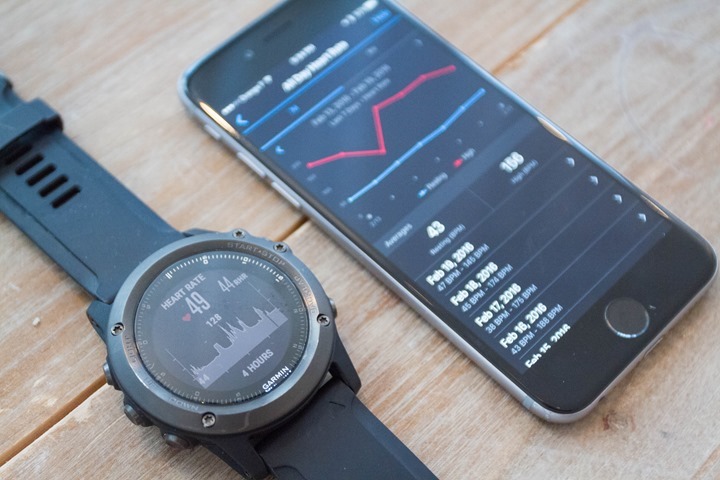
The Fenix3 adds in the same tracking capability as other recent Garmin fitness wearables with the optical HR sensors. Meaning, if you’re familiar with those (FR235, Vivoactive HR, Vivosmart HR) – it’s almost exactly the same here.
To start, Garmin has all the standard daily activity tracking such as steps walked, distance, and so on. That’s all pretty much dial-tone baseline these days.
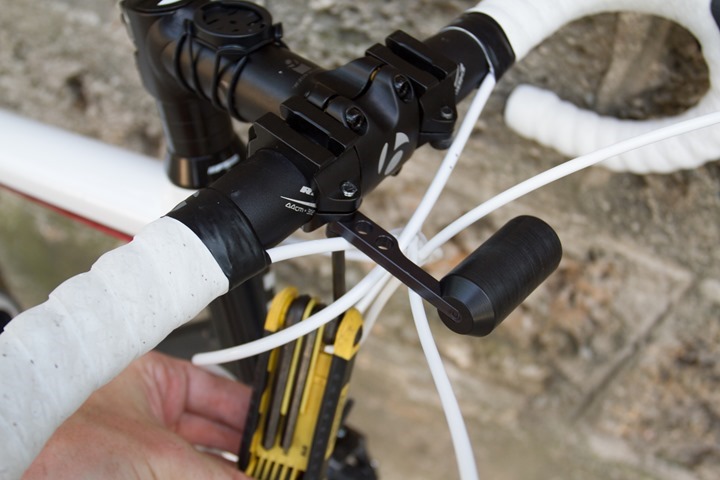
However, what’s new over the last few months is the 24×7 continual HR monitoring piece. This means that it leverages the optical HR sensor to track your heart rate throughout the day. It does this by turning on and off the green LED sensor at various times and then gathering your HR to record it. The unit uses the accelerometer to know how active you are. If you’re more active, it updates and records more frequently. Whereas if you’re less active (asleep), it does so far less frequently.
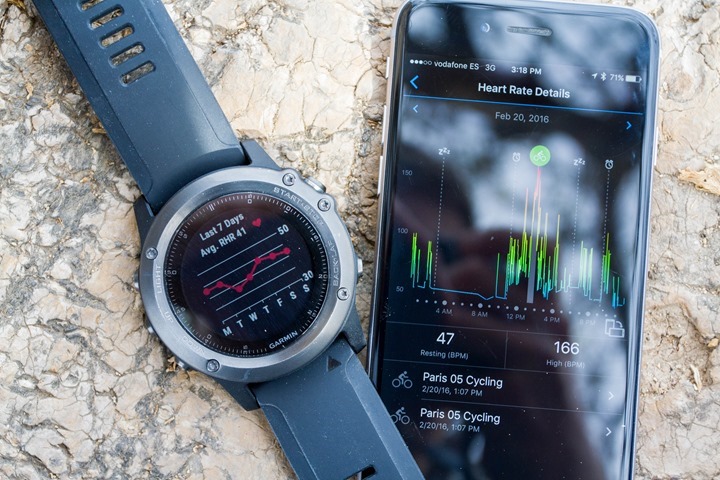
I wrote an entire post about this just last week in far more depth, so you may want to check that out there for more clarity on how the rest of the industry works (including Garmin). What I see though is that the Fenix3 HR acts fairly similar to how the FR235 does, and updates more frequently than the Vivosmart HR does. I just get far better battery life. About 1-2 weeks with roughly 1hr per day of GPS time (more on weekends)
However, I’m still prone to getting long multi-hour stretches without any resting HR updates. Here’s a handful of images of a few recent days that show the update rates.
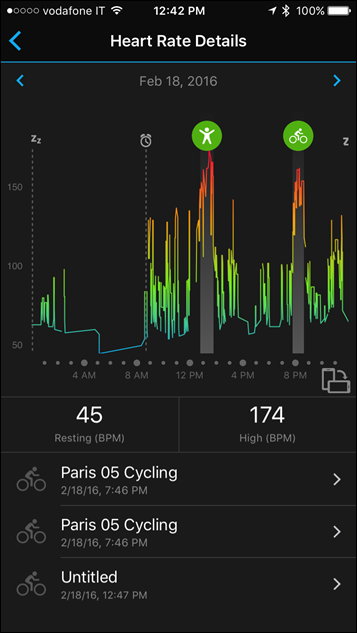
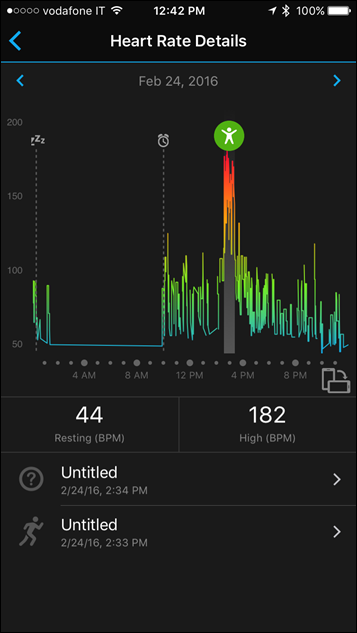
All of this data is available in two spots. First is the mobile app, as seen above & below.
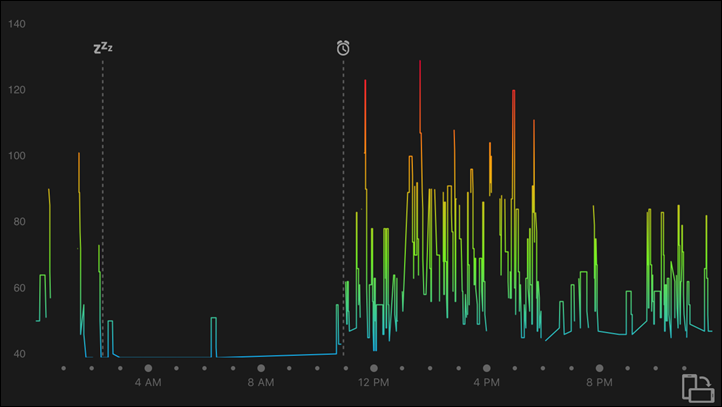
And then second, is on the device itself via the ‘Heart Rate’ widget, which you can access by simply pressing the up/down buttons. It’s basically like a dashboard page.
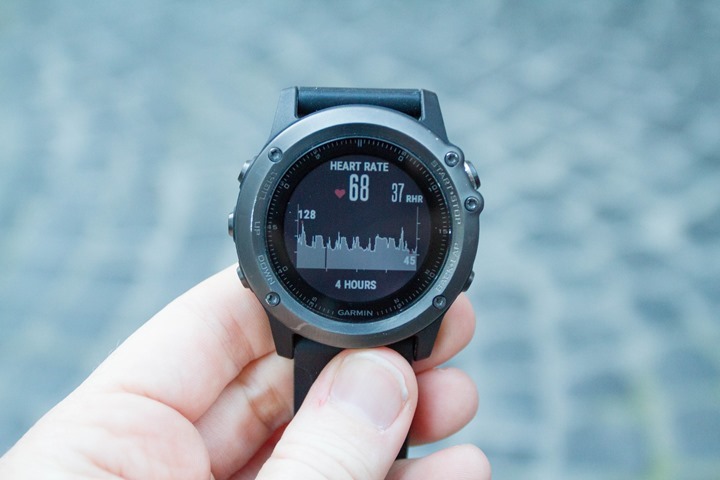
Within that page you can view the last four-hour graphical history, as well as a 7-day rolling history, which shows you the average RHR too (seen a few photos up).
For the most part, despite the lower recording rates while I’m asleep or semi-inactive (such as typing like this), it does seem to get my RHR metrics in the right ballpark. Typically for me my resting HR is in that 39bpm-42bpm range, and it seems to mostly be correct there.
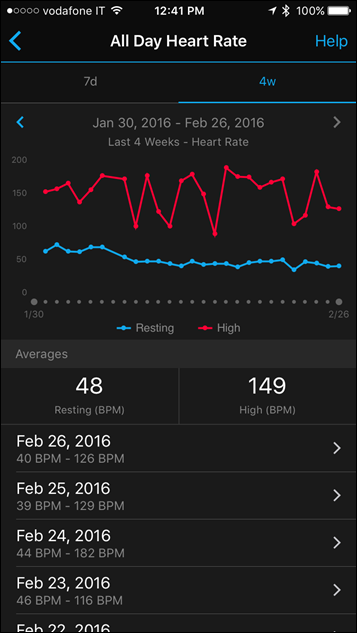
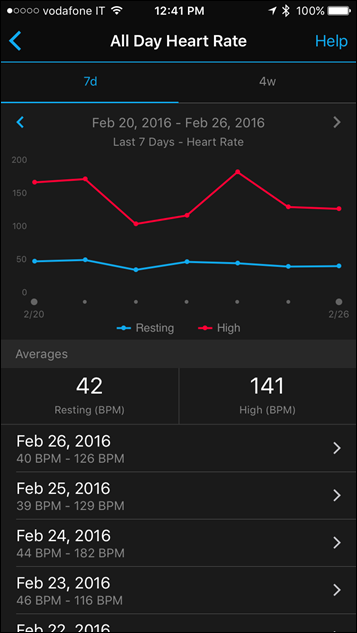
Next, it’s worthwhile point out that the Fenix3 HR also adds in Intensity Minutes, which was also added to the original Fenix3 back in January. Intensity Minutes is a new metric that Garmin added this past fall to other wearables that aims to track your total weekly exercise efforts. This is based around the 5 days by 30-minute guidance that many heath organizations recommend. So in this case, Garmin just totals it as 150 minutes of exercise per week – and then allows you to mix and match however you see fit.
You can also edit the amount as well, as seen below.
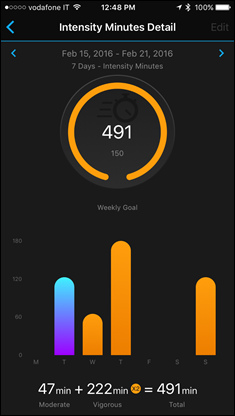
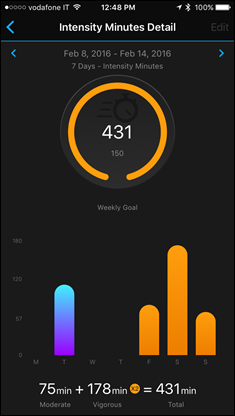

You’ll also see this on the watch itself, however by default the widget is in the ‘hidden’ state, so you’ll just need to enable it.
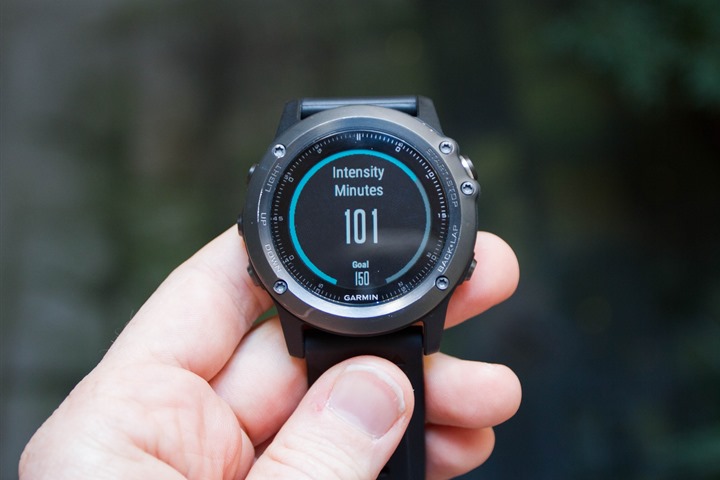
For most serious athletes who are looking at the Fenix3, they’ll likely hit this without too much thinking – which is probably why Garmin doesn’t show the screen by default. However, if you’re more of a casual athlete, then the 150 minutes guidance is a great goal to try and hit each week and is something that’s fairly achievable. Note that you don’t need to kill yourself on these workouts to count – so don’t fret too much there.
Optical HR in Workouts:
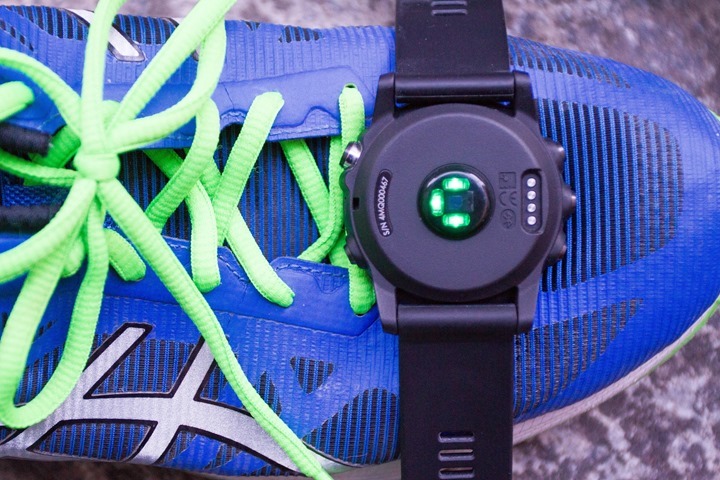
Now that we’ve covered the portion of the day where you’re not working out – let’s dive into the workout aspects. Like the 24×7 pieces, these too leverage the same HR sensor as other recent Garmin wearable products – so there isn’t a huge degree of hardware difference. However, there are some minor differences. Further, there is a bit more flexibility in battery than that of the other battery-constrained units (i.e. the Vivosmart HR).
The first thing to know is that the optical HR sensor isn’t enabled in all activities. Rather, only ones in which Garmin believes accuracy is high enough to be usable. So for example, it’s enabled in running and cycling – but not in swimming activities. For activities that it’s disabled in, you’ll need to leverage an ANT+ heart rate strap (and more on that later for swimming).
You can always disable the optical HR sensor on your own accord though, via the sensors menu. Think of it like a permanently paired sensor. You can choose when or whether it’s enabled.
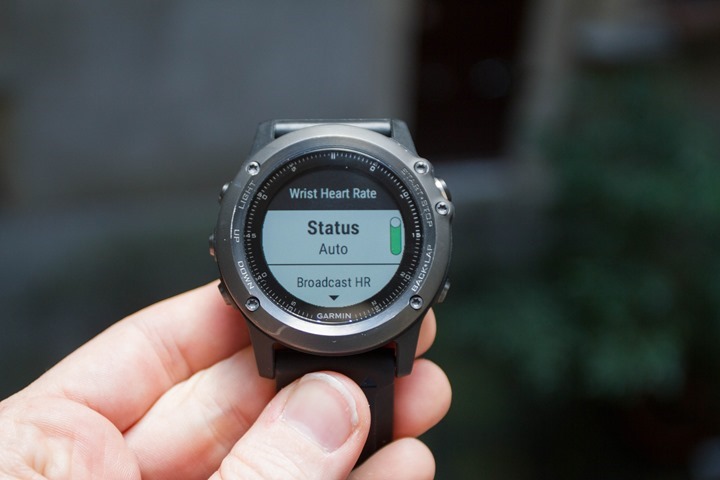
When you start a workout, it’ll start to acquire your HR. In most cases, this won’t take more than a few seconds. You want the little HR icon to illuminate a solid ‘red’ color. If it’s blinking, then it doesn’t have a (good) lock on it yet. So definitely wait until it’s happy. But again, this almost always happens in a couple seconds. In the below picture I have HR lock, but not yet satellite lock (the red circle around the outer edge).
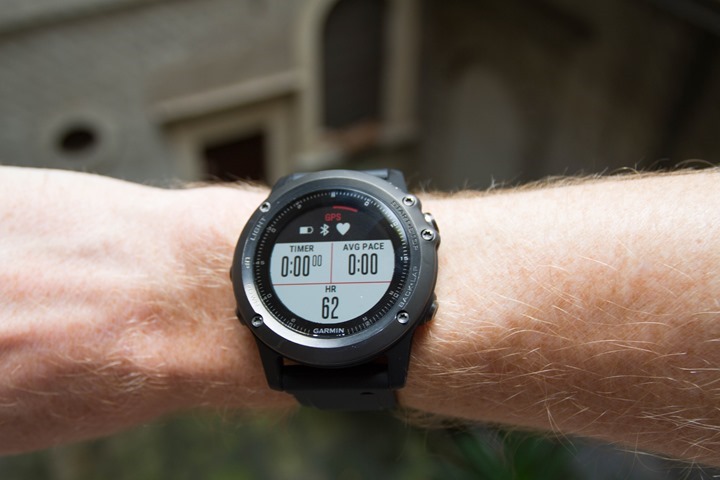
At that point you’ll want to wait for your GPS to acquire, again, more on that in the later section on GPS accuracy. Just ensure it’s green (not orange or red), then add a bit extra time for good measure. Now, you’re ready to roll!
While working out, the optical HR sensor gives you baseline HR data no different than that of the ANT+ HR strap. You’d never know the difference from looking at the main screen, since it’s just BPM (or whichever data metric you’ve configured).
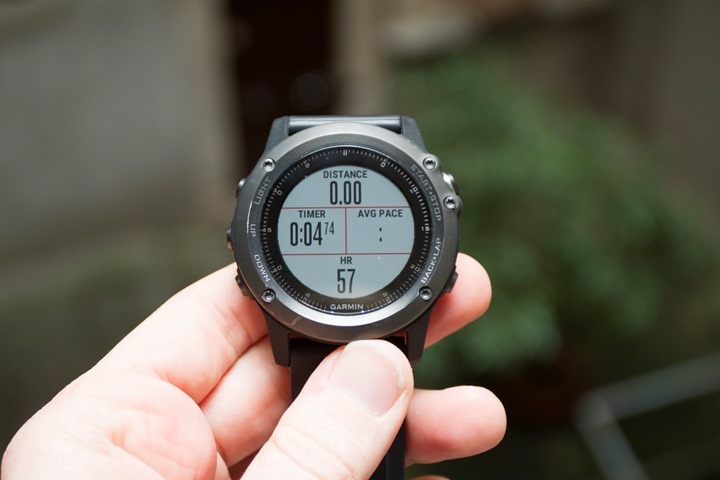
However, there are some features that are unable to use the optical HR signal fully. These are primarily due to the optical HR signal not giving enough data around heart rate variability (HRV) for these features to function.
Additionally, some Running Dynamics features require a separate accelerometer based in a chest strap (HRM-TRI or HRM-RUN) to be able to properly measure. So those ones won’t work either. Here’s what won’t work:
- Some Specific Running Dynamics Metrics: Ground Contact Time Balance and Vertical Ratio (others like cadence work just fine)
- Performance Condition and Stress Score
- Swimming HR: Both pool and openwater will require the HRM-TRI or HRM-SWIM HR straps.
Without a HR strap, those features will not work.
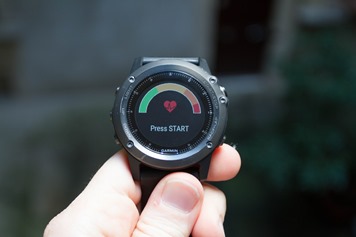
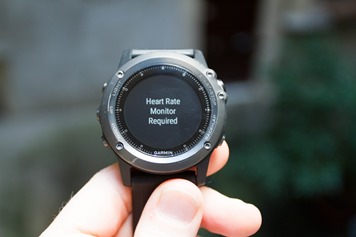
Just for clarity purposes, the following DO work with the optical HR sensor over the Fenix3 HR:
- VO2 Max metrics, Lactate Threshold metrics (auto or manual), Recovery Advisor, Race Predictor, Records
Note that you won’t always trigger a VO2Max (or Lactate Threshold) result each run. For example, in my case with the Fenix3, I appear to have only triggered it four times over the last four weeks. Note that for cycling VO2Max, you also need a power meter.
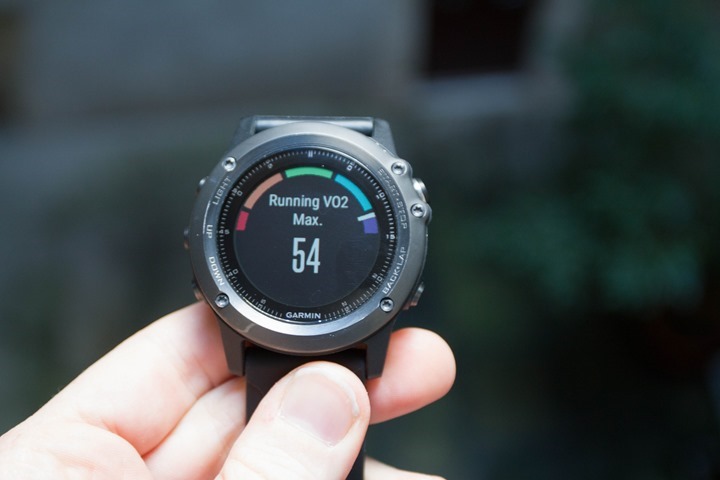
I have however managed to trigger a couple of Lactate Threshold test results along the way using just the optical HR sensor of the Fenix3 (via Auto Detect). This functionality was introduced with the FR630, and was carried through into the Fenix3 HR:
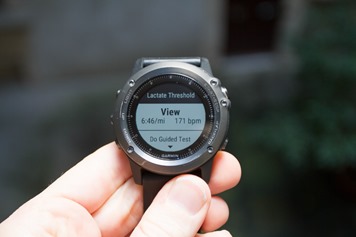
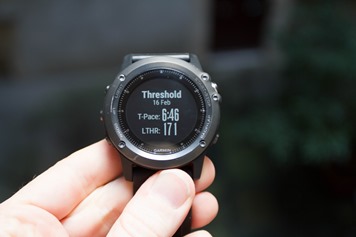
In my case, I suspect the Lactate Threshold test result was still a bit high, but as we saw with the FR630, it takes a number of ‘the right workouts’ (using auto detect mode) to get the correct result. If you do a guided test, you’re far more likely to get a more accurate result upfront. As to what the ‘right workouts’ are, it’s a bit hard to know exactly – other than usually more intense workouts with a longer period in the higher intensity zone.
HR Broadcasting:
Before we talk HR accuracy, I should briefly mention that the Fenix3 HR allows you to re-broadcast your heart rate over ANT+. This means that the Fenix3 HR will take your optical HR reading and then re-transmit it so that other ANT+ capable devices, such as a Garmin Edge, can pickup your HR reading.
To enable this you’ll go into the sensor menu (which is somewhat buried), and then select ‘Broadcast HR’:
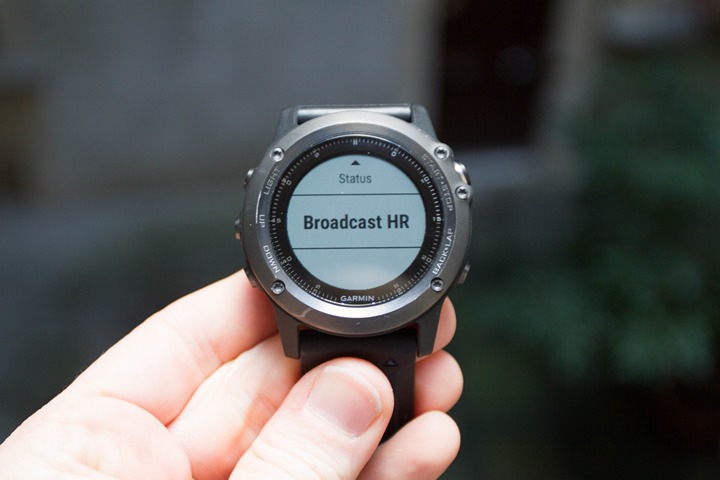
It’ll now show your current HR, and the time:
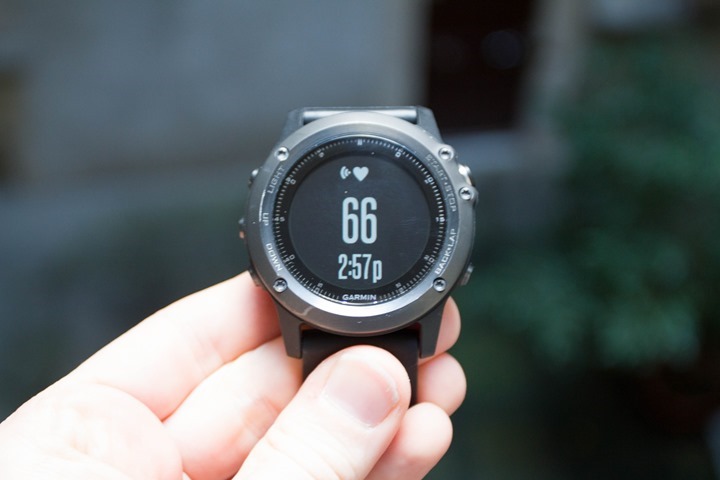
Meanwhile, if you grab something like a Garmin Edge device, you can pair it to the Fenix3 HR and receive your HR:
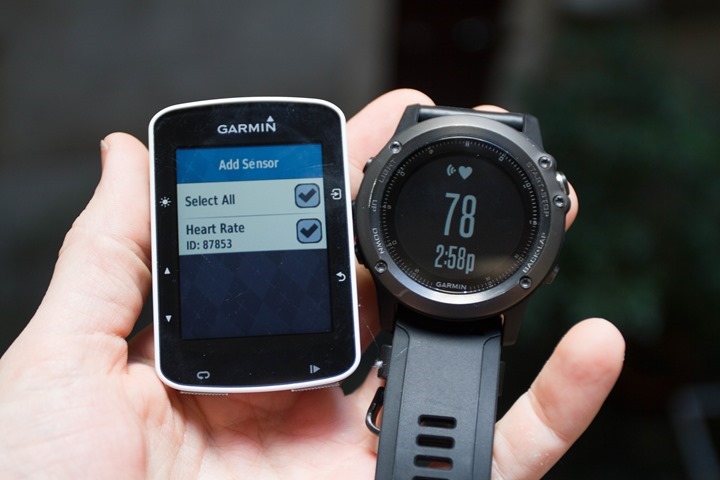
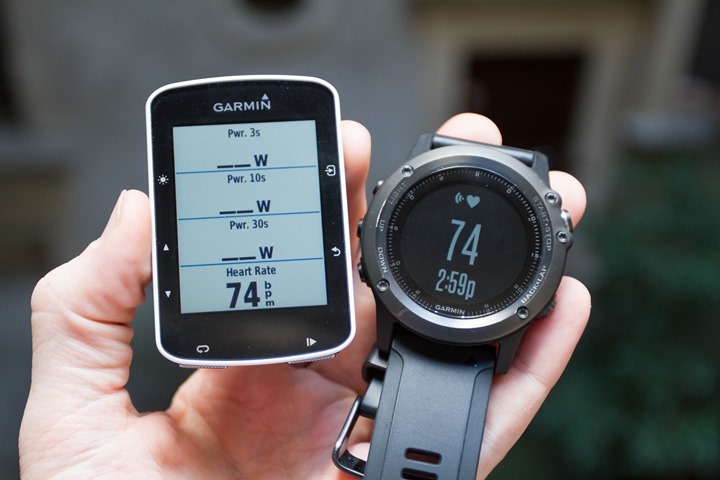
Note that one caveat is that you can’t see your regular activity screens in this mode, it requires you exit the broadcast mode:
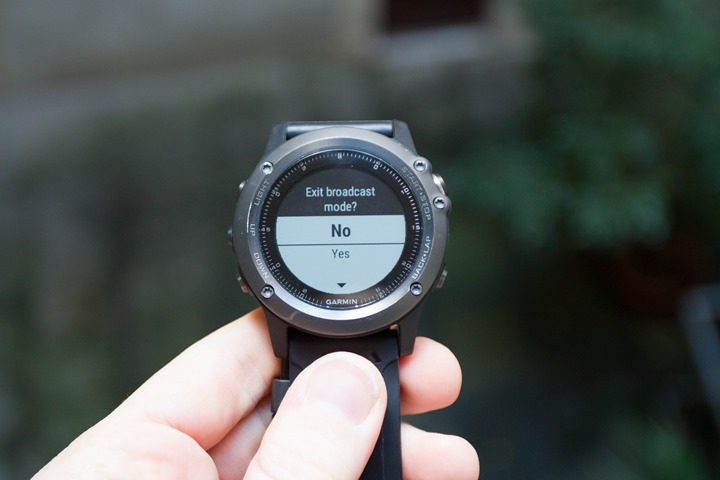
You can however actually start a GPS activity first, and then enable broadcast mode. So that does work, it’s just annoying that you can’t enable the broadcast mode and perhaps have it simply turn off at the end of the session when you save the file. I note this because the Vivoactive HR does actually allow you to enable broadcast mode and not impact your ability to otherwise use the watch.
HR Accuracy:
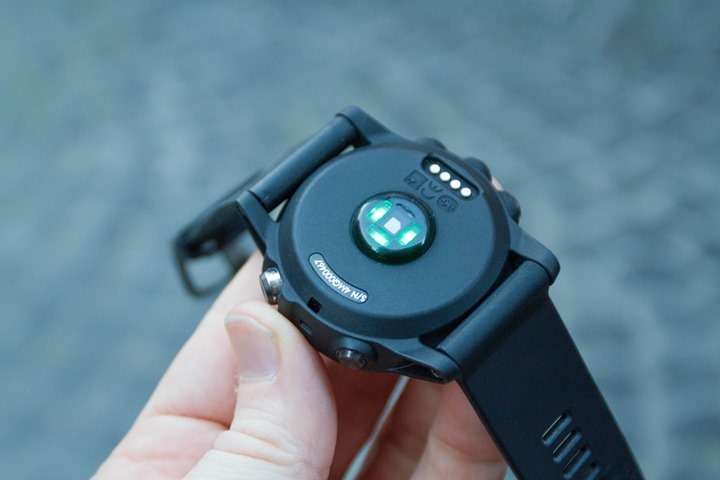
Now it’s time to dive into whether or not the optical HR sensor is actually accurate. The short version is that I found it built fairly well on top of the optical HR sensor of the FR235, and seems to have implemented a few software tweaks since then to improve in some of the edge cases of the FR235 that caused me challenges. Note that because all of these units share the same physical optical HR sensor, we tend to see Garmin update the firmware across the board. So while it’s been 3-4 months since I tested that, it has received firmware updates since then addressed at optical HR sensor tweaks. I expect that to continue.
We’ll start with running, then talk cycling, and finally finish up swimming. Basically, a backwards triathlon. And yes, I said swimming. What? You thought I wasn’t going to at least try it?
Ok, first up is something rather easy – just a simple easy-paced run. Now it’s funny in that this particular graph makes it look far less stable than it was. That’s mostly because my HR was basically 130, +/- 3bpm. So the scale on this graph makes it look kinda jumpy, when it’s really not that variable for the majority of it.

Here’s another run that was somewhat similar, from Barcelona this past weekend. In this case, you see a bit of variation at the beginning and then they match except for one spot around the 17-minute marker. For that first portion variation, I’d guess that the chest HR strap was actually wrong there, as it was an easy run that we eased into, so it’s unlikely that I’d have spikes with the chest strap then. I also had the Apple Watch on this run, but the data from it was mostly useless in this regard.

Next, we’ve got a tempo run of sorts. This nearly hour long session has four main chunks after the warm-up, with 2×10 minutes, then 2×5 minutes, then 4xSprints. You’ll see that it generally does quite well on tracking the harder intensity tempo portions. It does have a very slightly delay when I end each tempo section though, in that there’s some lag when I go from running hard to walking. It’s more apparent in the middle sets, though it does fairly well in the last 5-minute set.
You see that during the final 4xSprints, which are basically 30 seconds long and at full-out running intensity, than things get fairly close. It managed 3 out of 4 properly, which is actually much better than I’d see on the FR235 or many other wrist based optical HR sensors. You’ll note that in another similar run, it struggled a little bit on these. So sometimes it’s going to vary.

(Side note: There actually was a 3rd HR sensor on this graph, the Apple Watch. However the track was so horribly wrong that it distracted from the graph, but you can find the same run in the Apple Watch review, should you wish to see it.)
Here’s another tempo-ish run of sorts. It increases intensity over the first 30 minutes, then I do 3 different interval chunks of increasing intensities. In general, the unit tracked very well on the bulk of this. At the beginning, I see variations between the three units. I’m honestly not sure which track would be right. It wasn’t the Apple Watch, but it could have been either the Fenix3 HR or the HR strap. This is one of those examples where in low temperatures chest straps can struggle a bit.
You also see that slight delay at the end of a hard set, as well as being a bit short during the 30-second intervals.

Next, a longer run from this past weekend. This run was split up into 10 minute chunks with varying intensities. You can see rather easily that it tracked quite well across all of these. Interestingly, at one point at the 57-minute marker while running (and not stopping) I adjusted the strap to make it tighter. For about the following minute, the unit wasn’t terribly happy about that. Lesson of the day: Don’t adjust the strap while running high cadence drills.

(Note that on this particular run I was running a beta build, in the last few minutes of the run, the unit did suffer a crash and restarted. So I’ve focused on the 1hr 25mins prior to that point. Again, it was a beta build.)
How about a switch up to cycling? This is where I’ve seen some improvement compared to the FR235 (or the Vivosmart HR). Take for example this ride, which was on the relatively smooth roads around the Spanish island of Mallorca. In this case, the unit does very well except for one brief section at about the 55ish marker. This is ironically when I was actually OFF the bike, taking a couple of quick photos before riding back home. So you can judge that failure however you see fit. My guess is that the much sharper cadence of my cycling shoes on the concrete tricked it (cadence often tricks optical HR). You see a slight delay again in the last big dip as I crested a hill and started descending, but it’s not horrible.

However, it’s not always so good. I find that the more variability I introduce into a ride, the more it struggles. For example, on this ride across the city (full of cobbles, rough roads, stop/go, etc…), it seems to have some tough times. I can’t say I’d use the sensor much in cycling when it looks like this.

To help settle this a bit, let’s go inside on a trainer for a workout. In this case you can see that it tracked fairly well across the majority of the workout. You see a few brief seconds where it momentarily separated or didn’t catch a significant shift. But otherwise, it’s fairly similar.

Thus proving that the rougher roads is really the problem here, not so much the position of cycling. So the summary there for cycling is that it’s likely OK when you’ve got smoother roads and more stable efforts. However, when you’ve got rougher roads it seems to struggle more and is less reliable.
Finally, a brief look at swimming. Yes, I had to try it out even though it’s disabled for swim mode. To track it, I simply put the watch into indoor running mode. This meant I didn’t get any swim metrics (pace/laps/distance), but I did get HR.
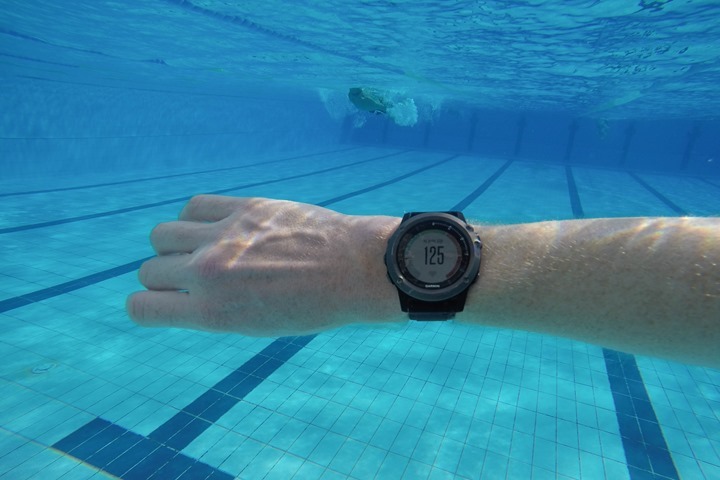
For my swim I wore the HRM-SWIM paired to a FR920XT on one wrist, and then the Fenix3 HR on the other wrist
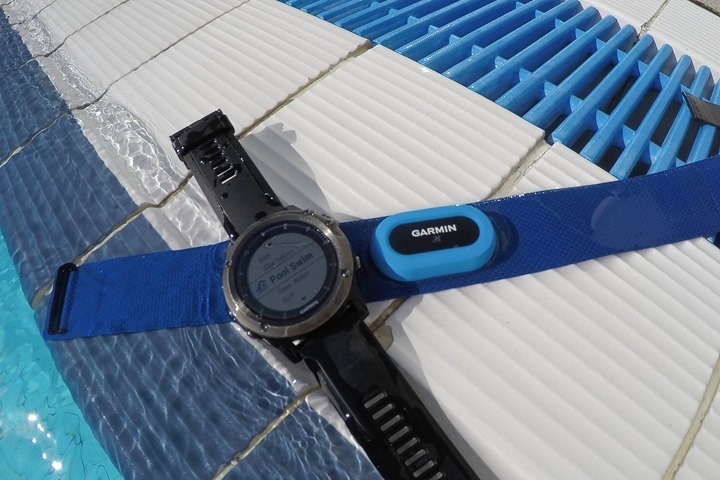
I then went about my swim sets, which included 3x500m, followed by alternating 50m hard/50 meters easy. This was the result. Purple is the Fenix3HR, red is the HRM-SWIM.

For those that aren’t clear – no, it doesn’t track well. Garmin says they’re continuing to work on accuracy in the water, and if they can get it to an acceptable level, they’ll enable it for the Fenix3 HR.
GPS Accuracy:
I wanted to briefly touch on GPS accuracy within the Fenix3 HR post, despite the fact that Garmin claims no components have changed between the original Fenix3 and the Fenix3 HR.
There has been much ado in some circles about the GPS accuracy of the Fenix3, specifically (mostly) in trail environments, though occasionally in city environments. The majority of my running is in the city, though I do go out into the trails from time to time (including during this review cycle). My city is the dense concrete buildings of Paris, which aren’t quite as tall as skyscrapers of NYC, though they make up for it in tiny little one-lane streets. I also ride out of the city as well, so I’ve got plenty of non-city terrain too. For example, my recent long-weekend in the mountains of Mallorca.
Overall, I’ve seen generally good performance with the Fenix3 HR. There have been a handful of times (two specifically) where it has struggled. However, out of the 30+ days of workouts otherwise, I haven’t seen any issues. Nor has the eagle-eyed followers on my Strava account. My Fenix3 HR is setup to wirelessly sync there, so the vast majority of the time it’ll sync via WiFi well before I get out of the shower on a workout. As a result I’ll find more than enough comments from the gallery on what folks think.
A prime example being this run from a few weeks ago, where the Fenix3 HR shortly after starting went for a swim around some 8-10 story buildings. What’s interesting is you can really see it struggling the first portion until that point. So even though I had the green go on the satellite track, I only waited about 1-2 seconds before pressing start (because The Girl was giving me the Death Stare that we better get going). Normally, I’d end up waiting 20-30 seconds longer – which seems to help significantly. It’s as if the unit isn’t really quite ready yet.

Or nearby again, where it struggled the following night crossing a bridge. It’s odd, I see this little section causing pain for many GPS devices, not just the Fenix3 HR though. Perhaps it’s the taller buildings causing issues on the right side there.

However, the vast majority of the time the unit performs solidly. I’m able to zoom in on complex sections throughout many runs and find it’s tracked well or on par with the FR920XT:

Or again, through the mountains without issue:

Or, through trails. In fact, this earlier chart from last month with the Suunto Ambit3 Vertical – actually compared the Fenix3 HR too.


One of the challenges with the Fenix3 in general is that it’s sold so well (well into the hundreds of thousands of units, if not closer to a million units). As such, you see a higher volume of discussion on it, more so than really any other unit. So even if the total ‘bad-track’ volume is the same as other watches on any given random day, then you’re going to hear more of it – just because there’s 20, 30, or perhaps 50 times more Fenix3’s out there than Suunto Ambit or Polar V800 devices. Just my two cents.
Product Comparisons:
I’ve added the Garmin Fenix3 HR to the product comparison tables, so you can mix and match any of the products I’ve reviewed to see which features they have. For the below comparison purposes, I’ve placed the Fenix3 HR next to the Fenix3 (original), and the Suunto Ambit3 Peak. But remember you can create your own product comparison table as you see fit anytime with the product comparison tool here.
Copyright DC Rainmaker – Updated January 4th, 2017 @ 4:19 amNew Window
Price$549$499$499
Product Announcement DateJan 5th, 2016January 5th, 2015July 10th, 2014
Actual Availability/Shipping DateFebruary 2016February 2015Sept 2014
GPS Recording FunctionalityYesYesYes
Data TransferUSB/Bluetooth Smart/WiFiUSB/Bluetooth Smart/WiFiUSB & Bluetooth Smart
WaterproofingYes – 100mYes – 100mYes – 100m
Battery Life (GPS)Up to 50hrs in GPS with optical off, about 20-25% less with optical HR onUp to 50hrs in GPSUp to 200 Hours
Recording Interval1S OR SMART1S OR SMARTVariable
Satellite Pre-Loading via ComputerYesYesYes
Quick Satellite ReceptionGreatGreatGreat
AlertsVibrate/Sound/VisualVibrate/Sound/VisualSound/Visual
Backlight GreatnessGreatGreatGreat
Ability to download custom apps to unit/deviceYesYesYes
Acts as daily activity monitor (steps, etc…)YesYesMinimal
Can control phone musicYEsYesNo
Has music storage and playbackNoNoNo
Bluetooth Legacy (pre-4.0) to PhoneNoNoNo
Bluetooth Smart (4.0+) to Phone UploadingYesYesYes
Phone Notifications to unit (i.e. texts/calls/etc…)YesYesYes
Live Tracking (streaming location to website)YesYesNo
Group trackingNoNo
Emergency/SOS Message Notification (from watch to contacts)NoNoNo
Built-in cellular chip (no phone required)NoNoNo
Designed for cyclingYesYesYes
Power Meter CapableYesYesYes
Power Meter Configuration/Calibration OptionsYesYesYes
Power Meter TSS/NP/IFYesYesNo
Speed/Cadence Sensor CapableYesYesYes
Strava segments live on deviceNoNoNo
Crash detectionNoNo
Designed for runningYesYesYes
Footpod Capable (For treadmills)YEsYesYes
Running Dynamics (vertical oscillation, ground contact time, etc…)With HRM-TRI or HRM-RUN (Not via Optical HR)With HRM-TRI or HRM-RUNNo
VO2Max EstimationYEsYesYes
Race PredictorYesYesNo
Recovery AdvisorYesYesYes
Run/Walk ModeYEsYesNo
Designed for swimmingYesYesYes
Openwater swimming modeYesYesYes
Lap/Indoor Distance TrackingYesYesYes
Record HR underwaterWITH HRM-TRI/HRM-SWIM (Not with optical HR)WITH HRM-TRI/HRM-SWIMYes
Openwater Metrics (Stroke/etc.)YesYesYes
Indoor Metrics (Stroke/etc.)YEsYEsYes
Indoor Drill ModeYEsYesYes
Indoor auto-pause featureYEsNoNo
Change pool sizeYesYesYes
Indoor Min/Max Pool Lengths17M/18Y TO 150Y/M17M/18Y TO 150Y/M15m/y to 1,200m/y
Ability to customize data fieldsYEsYesYes
Can change yards to metersYEsYesYes
Captures per length data – indoorsYEsYesYes
Indoor AlertsYesYesNo
Designed for triathlonYesYesYes
Multisport modeYesYesYes
Create/Follow custom workoutsYesYesNo
On-unit interval FeatureYesYEsBarely
Training Calendar FunctionalityYesYesNo
Auto Start/StopYesYesYes
Virtual Partner FeatureYesYesNo
Virtual Racer FeatureYEsYesNo
Records PR’s – Personal Records (diff than history)YesYesNo
Day to day watch abilityYesYesYes
Hunting/Fishing/Ocean DataYesYesNo
Tidal Tables (Tide Information)NoNoNo
Jumpmaster mode (Parachuting)YesNoNo
GeocachingVia GPS coordinatesVia GPS coordinatesNo
Weather Display (live data)yESYesNo
Follow GPS Track (Courses/Waypoints)YesYEsYes
Markers/Waypoint DirectionYesYesYes
Routable/Visual Maps (like car GPS)NoNoNo
Back to startYesYesYes
Impromptu Round Trip Route CreationNoNoNo
Download courses/routes from phone to unitYesYesYes
Altimeter TypeBarometricBarometricBarometric
Compass TypeMagneticMagneticMagnetic
Optical Heart Rate Sensor internallyYesNoNo
Heart Rate Strap CompatibleYesYesYes
ANT+ Heart Rate Strap CapableYesYesNo
ANT+ Speed/Cadence CapableYEsYesNo
ANT+ Footpod CapableYEsYesNo
ANT+ Power Meter CapableYesYesNo
ANT+ Weight Scale CapableNoNoNo
ANT+ Fitness Equipment (Gym)NoNoNo
ANT+ Lighting ControlNoNoNo
ANT+ Bike Radar IntegrationNoNoNo
ANT+ Trainer Control (FE-C)NoNoNo
ANT+ Remote ControlNo (can control VIRB though)No (can control VIRB though)No
ANT+ eBike CompatibilityNoNoNo
ANT+ Muscle Oxygen (i.e. Moxy/BSX)With Connect IQ AppsNo
ANT+ Gear Shifting (i.e. SRAM ETAP)NoNo
Shimano Di2 ShiftingNoComing in updateNo
Bluetooth Smart HR Strap CapableNoNoYes
Bluetooth Smart Speed/Cadence CapableNoNoYes
Bluetooth Smart Footpod CapablenONoYes
Bluetooth Smart Power Meter CapableNoNoYes
Temp Recording (internal sensor)YesYesYes
Temp Recording (external sensor)YesYesNo
Compatible with Firstbeat HR toolsYesYesYes
PC ApplicationGarmin ExpressGarmin ExpressMoveslink Agent
Web ApplicationGarmin ConnectGarmin ConnectSuunto Movescount
Phone AppiOS/Android/Windows PhoneiOS/Android/Windows PhoneiOS/Android
Ability to Export SettingsNoNoNo
Amazon LinkLinkLinkLink
Clever Training – Save a bunch with Clever Training VIP programLinkLinkLink
Clever Training – Save a bunch with Clever Training VIP programLinkLinkLink
Review LinkLinkLinkLink
And remember again, you can mix and match your own comparison chart using the product comparison tool here.
Summary:
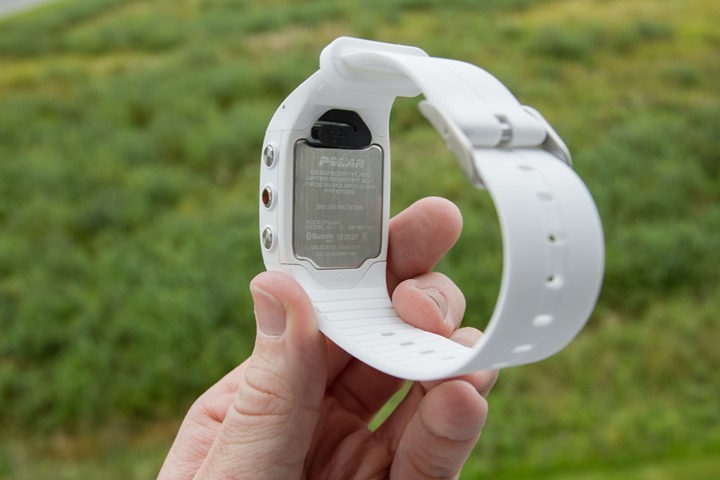
So is it worth the extra cash over the regular Fenix3? That’s really what this all comes down to, right?
It depends a bit on how you train and what sports you use it for. For most people in running, it’ll likely do the trick most of the time. There are certain pieces that lag a bit, but the majority of the time it’s good. Meanwhile, for cycling it’s going to depend on the road conditions a bit. I’d probably just use a HR strap there for now. And lastly, for swimming, it’s not yet enabled – so you’d need a strap anyway if you wanted swimming HR. Do keep in mind that if you use a quick release kit today with a FR920XT or Fenix3, then this won’t work with that. But if you step away from the typical swim/bike/run triathlete realm that this multi-sport device is designed for, and instead focus on a less intense athlete – then it’s likely to fit the bill rather well.
The 24×7 piece, while it could use some more tweaking, is getting there. I just wish they’d allow me to control the rate of optical HR update (and thus battery burn) to get a bit more accurate data at rest (sitting or sleeping).
As for the rest of the watch, Garmin has added boatloads of small features to the Fenix3 lineup over the past year. None of which are earth-shattering, but many are appealing to specific niche requirements that folks have had. And in the process, they are burying Suunto and Polar in terms of the feature arms race. Some might argue however that at times, that arms race has led Garmin to introduce more bugs than their competitors. And that’s likely true. However, I’d also wager that the vast majority of the bugs tend not to impact everyone (or even 1-2% of everyone). Additionally, their semi-new open beta program has helped to keep those bugs for the people that love being on the bleeding edge (and providing feedback).
Overall, it’s pretty hard to beat the Fenix3 series, HR or otherwise, in today’s high-end GPS watch market. On the flip side, one can buy more reliable 3rd party optical HR sensors for less than the added cost between the Fenix3 HR and the base Fenix3. It then really comes down to a choice between accuracy and convenience (and 24×7 HR monitoring value).
Found this review useful? Or just want a good deal? Here’s how:

Hopefully you found this review useful. At the end of the day, I’m an athlete just like you looking for the most detail possible on a new purchase – so my review is written from the standpoint of how I used the device. The reviews generally take a lot of hours to put together, so it’s a fair bit of work (and labor of love). As you probably noticed by looking below, I also take time to answer all the questions posted in the comments – and there’s quite a bit of detail in there as well.
I’ve partnered with Clever Training to offer all DC Rainmaker readers exclusive benefits on all products purchased. By joining the Clever Training VIP Program, you will earn 10% points on this item and 10% off (instantly) on thousands of other fitness products and accessories. Points can be used on your very next purchase at Clever Training for anything site-wide. You can read more about the details here. By joining, you not only support the site (and all the work I do here) – but you also get to enjoy the significant partnership benefits that are just for DC Rainmaker readers. And, since this item is more than $75, you get free 3-day (or less) US shipping as well.
Garmin Fenix3 HR (select drop-down for specific variant)
Additionally, you can also use Amazon to purchase the unit (though, no discount). Or, anything else you pickup on Amazon helps support the site as well (socks, laundry detergent, cowbells). If you’re outside the US, I’ve got links to all of the major individual country Amazon stores on the sidebar towards the top.
Thanks for reading! And as always, feel free to post comments or questions in the comments section below, I’ll be happy to try and answer them as quickly as possible.

